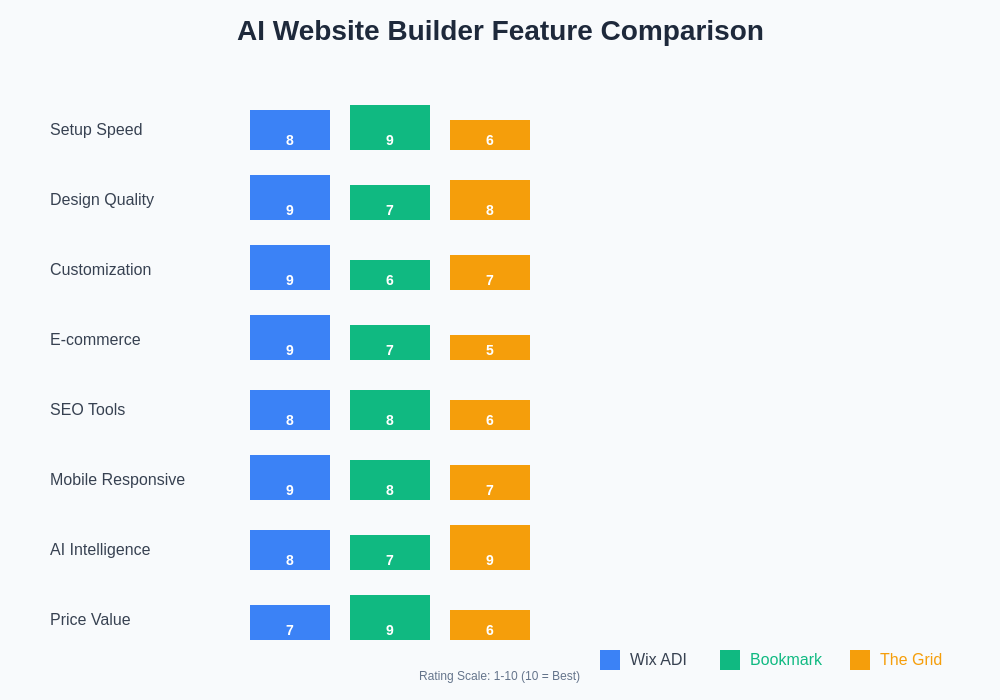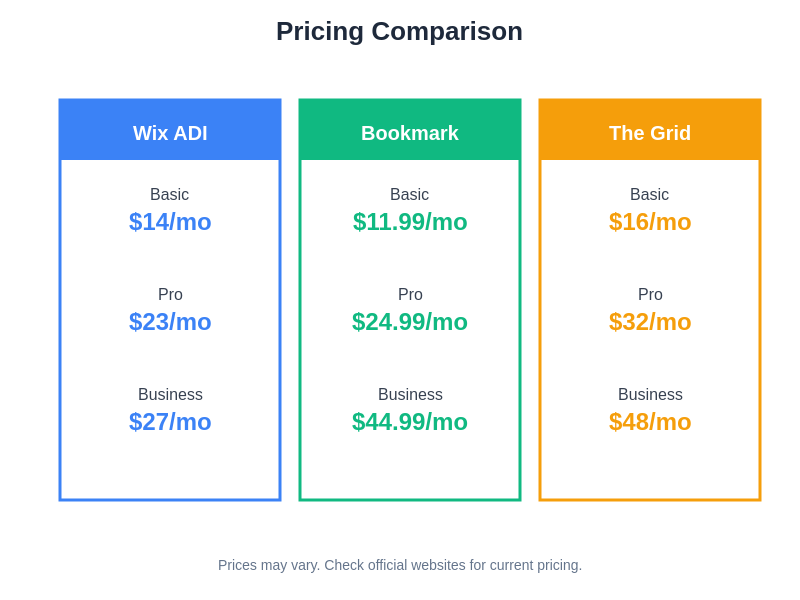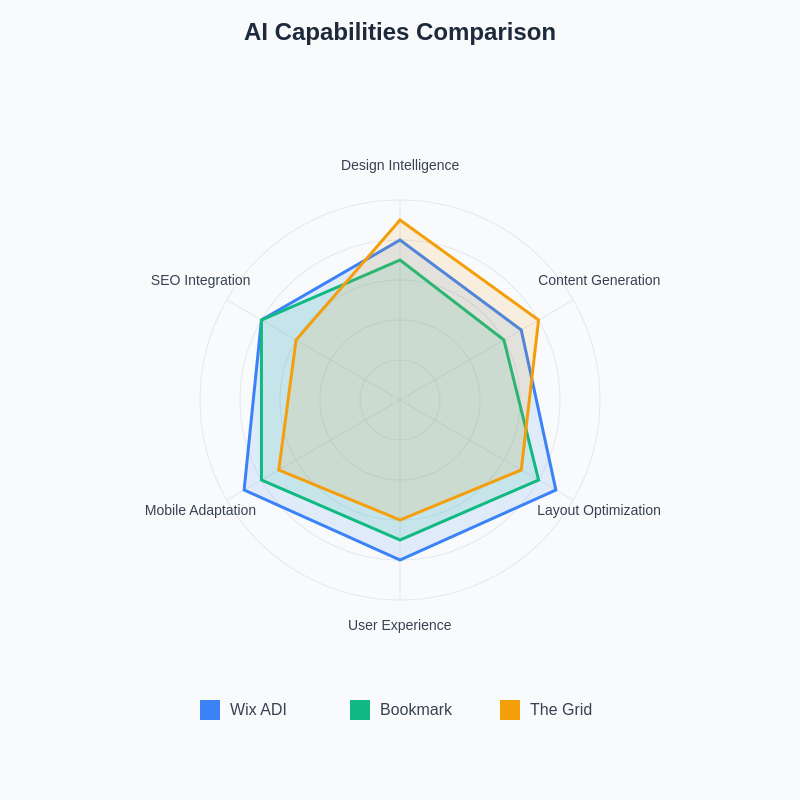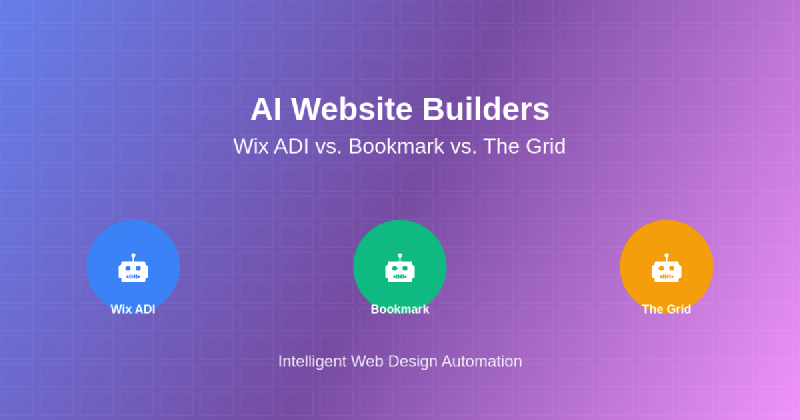The evolution of web development has reached a revolutionary milestone with the emergence of artificial intelligence-powered website builders that can create professional, functional websites without requiring traditional coding knowledge or extensive design expertise. This transformation has democratized web development, enabling individuals and businesses to establish compelling online presences through intelligent automation that understands user requirements and translates them into sophisticated web solutions.
Explore the latest AI innovations shaping web development and discover how artificial intelligence is revolutionizing the way websites are conceived, designed, and deployed across various industries and use cases. The competitive landscape of AI website builders has intensified significantly, with platforms like Wix ADI, Bookmark, and The Grid leading the charge in automated web design innovation.
The Rise of Intelligent Web Creation
The traditional approach to website development required substantial technical knowledge, significant time investment, and often considerable financial resources to achieve professional results. AI-powered website builders have fundamentally disrupted this paradigm by introducing intelligent systems capable of understanding user intent, analyzing business requirements, and automatically generating customized websites that align with specific goals and aesthetic preferences.
This technological advancement represents more than mere automation; it embodies a sophisticated understanding of design principles, user experience optimization, and content organization that previously required years of professional experience to master. The integration of machine learning algorithms enables these platforms to continuously improve their design capabilities while adapting to emerging web standards and user expectations.
The democratization of web development through AI has opened unprecedented opportunities for small businesses, entrepreneurs, and individuals who previously lacked the resources or technical expertise to establish professional online presences. This shift has created a more inclusive digital landscape where compelling websites can be created through conversational interfaces and intelligent automation rather than complex programming languages and design software.
Wix ADI: Pioneering Artificial Design Intelligence
Wix Artificial Design Intelligence represents one of the most sophisticated and widely adopted AI website building platforms available today. The system employs advanced machine learning algorithms to analyze user responses to strategic questions about business goals, aesthetic preferences, and functional requirements, subsequently generating fully customized websites that reflect individual brand identities and operational needs.
The platform’s intelligence extends beyond simple template selection to encompass comprehensive content creation, image optimization, layout arrangement, and feature integration based on industry-specific best practices and user behavior patterns. Wix ADI demonstrates remarkable sophistication in understanding contextual requirements, automatically selecting appropriate color schemes, typography combinations, and structural elements that enhance user engagement and conversion potential.
Experience advanced AI capabilities with Claude for enhanced creative problem-solving and intelligent content generation that complements automated website building processes. The synergy between different AI technologies creates comprehensive solutions that address various aspects of digital presence establishment and optimization.
The platform’s learning capabilities enable continuous improvement through user feedback and interaction patterns, resulting in increasingly sophisticated design recommendations and feature suggestions that align with evolving web standards and user expectations. This adaptive intelligence ensures that websites created through Wix ADI remain current with contemporary design trends while maintaining functionality across various devices and browsers.
Wix ADI’s integration with comprehensive business tools, including e-commerce functionality, appointment scheduling, customer relationship management, and analytics tracking, creates holistic solutions that extend far beyond basic website creation. This ecosystem approach enables users to establish complete digital business infrastructures through intelligent automation and seamless integration of essential business functions.
Bookmark: Streamlined AI Web Development
Bookmark’s AIDA (Artificial Intelligence Design Assistant) represents a streamlined approach to AI-powered website creation that emphasizes speed, simplicity, and intuitive user experience. The platform distinguishes itself through remarkably efficient onboarding processes that can generate functional websites within minutes of initial user interaction, making it particularly attractive for users who prioritize rapid deployment and straightforward functionality.
The intelligence behind Bookmark’s system focuses on understanding core business requirements and translating them into clean, professional designs that emphasize readability, navigation efficiency, and mobile responsiveness. This approach prioritizes practical functionality over elaborate visual complexity, resulting in websites that perform consistently across various devices and user scenarios while maintaining professional appearance standards.
Bookmark’s AI demonstrates particular strength in content organization and information architecture, automatically creating logical navigation structures and content hierarchies that enhance user experience and search engine optimization. The platform’s understanding of industry-specific requirements enables automatic integration of relevant features and functionality that align with particular business types and operational models.
The system’s machine learning capabilities analyze successful website patterns and user engagement metrics to inform design decisions and feature recommendations, ensuring that generated websites incorporate proven strategies for user retention and conversion optimization. This data-driven approach to web design automation creates websites that perform effectively from initial deployment while providing foundations for future growth and optimization.
Bookmark’s emphasis on simplicity extends to its content management system, which enables users to easily update and modify their websites without requiring technical knowledge or complex interface navigation. This accessibility ensures that AI-generated websites remain dynamic and current through ongoing user engagement and content updates.
The Grid: Experimental AI Design Innovation
The Grid represents one of the most ambitious attempts to create truly intelligent web design automation through advanced artificial intelligence that promises to understand design principles at fundamental levels and apply them automatically to create unique, compelling websites. The platform’s approach emphasizes creative automation that goes beyond template-based generation to produce genuinely original designs tailored to specific content and business requirements.
The Grid’s AI system attempts to understand design aesthetics, content relationships, and user experience principles through sophisticated analysis of visual elements, content structures, and interaction patterns. This approach aims to replicate the decision-making processes of professional web designers while introducing creative variations and optimizations that might not occur through traditional design methodologies.
Enhance your research capabilities with Perplexity to gather comprehensive information about emerging AI technologies and web development trends that influence intelligent design automation platforms. The rapidly evolving landscape of AI web development requires continuous learning and adaptation to emerging technologies and methodologies.
The platform’s experimental nature means that it often introduces innovative features and approaches that push the boundaries of automated web design, though this innovation sometimes comes at the cost of consistency and predictability compared to more established platforms. The Grid’s commitment to advancing AI design capabilities makes it particularly interesting for users who want to explore cutting-edge approaches to web creation.
The system’s learning algorithms continuously analyze design effectiveness and user engagement patterns to refine its understanding of successful web design principles and improve future website generation. This experimental approach contributes to the broader advancement of AI design capabilities while providing users with access to innovative web creation technologies.
Comparative Analysis: Features and Capabilities
The landscape of AI website builders reveals distinct approaches to automated web creation, each with unique strengths and limitations that appeal to different user requirements and preferences. Understanding these differences enables informed decision-making based on specific project needs, technical requirements, and long-term goals for online presence development.
Wix ADI excels in comprehensive feature integration and business tool connectivity, providing users with complete digital business solutions that extend far beyond basic website functionality. The platform’s extensive template library, combined with AI-driven customization capabilities, creates virtually unlimited possibilities for website personalization while maintaining professional quality standards across diverse industries and use cases.
Bookmark’s strength lies in its streamlined approach to website creation that prioritizes efficiency and ease of use without sacrificing professional quality or essential functionality. The platform’s rapid deployment capabilities and intuitive content management system make it particularly suitable for users who need functional websites quickly while maintaining the flexibility to evolve their online presence over time.
The Grid’s experimental approach offers unique creative possibilities through advanced AI design automation that attempts to understand and apply design principles at sophisticated levels. While this innovation creates opportunities for truly original web designs, it also introduces elements of unpredictability that may not align with users who prefer consistent, proven design approaches.
User Experience and Interface Design
The user experience provided by AI website builders plays a crucial role in determining platform adoption and long-term satisfaction among users with varying levels of technical expertise and design knowledge. Each platform approaches user interaction differently, reflecting distinct philosophies about how AI should interface with human creativity and decision-making processes.
Wix ADI employs a conversational approach that guides users through strategic questions about their business goals, aesthetic preferences, and functional requirements. This methodology creates engaging onboarding experiences that feel collaborative rather than automated, helping users feel involved in the design process while benefiting from AI optimization and automation.
Bookmark emphasizes simplicity and speed in its user interface, minimizing the complexity of decision-making while maintaining sufficient customization options to create personalized websites. This approach appeals particularly to users who prefer straightforward processes and clear, predictable outcomes without extensive customization requirements or complex feature integration.
The Grid’s interface reflects its experimental nature, sometimes presenting users with unexpected design choices and creative interpretations that can be either inspiring or confusing depending on user preferences and expectations. This approach creates opportunities for surprising creative outcomes while potentially challenging users who prefer more predictable design processes.
Performance and Technical Capabilities
The technical performance of AI-generated websites represents a critical factor in determining platform suitability for various business applications and user requirements. Performance considerations include loading speeds, mobile responsiveness, search engine optimization capabilities, and integration with third-party services and tools.
Wix ADI demonstrates strong technical performance across most metrics, with particular strengths in mobile optimization and third-party integration capabilities. The platform’s extensive ecosystem of business tools and services creates comprehensive solutions for complex business requirements while maintaining consistent performance standards across various device types and network conditions.

The comprehensive feature analysis reveals distinct strengths and positioning strategies among the leading AI website builders, with each platform excelling in different aspects of automated web development and user experience delivery.
Bookmark’s technical approach emphasizes clean, efficient code generation that prioritizes loading speed and cross-device compatibility. The platform’s streamlined approach to feature integration results in websites that perform consistently across various technical environments while maintaining the flexibility to incorporate additional functionality as business needs evolve.
The Grid’s technical performance varies depending on the complexity of AI-generated designs and the experimental features incorporated into specific websites. While the platform can produce technically sophisticated results, the experimental nature of its approach sometimes creates inconsistencies in performance optimization and compatibility across different browsers and devices.
Pricing and Value Proposition Analysis
The economic considerations surrounding AI website builders involve complex evaluations of feature sets, long-term costs, and value delivery relative to traditional web development alternatives. Each platform approaches pricing differently, reflecting distinct business models and target market strategies that influence overall value propositions for different user types.
Wix ADI offers tiered pricing structures that accommodate various business sizes and feature requirements, from basic websites to comprehensive e-commerce solutions with advanced business tool integration. The platform’s extensive feature set and ecosystem approach provide substantial value for businesses that benefit from integrated solutions and comprehensive functionality.
Bookmark’s pricing strategy emphasizes affordability and straightforward cost structures that appeal to small businesses and individual users who prioritize essential functionality without complex feature requirements. The platform’s efficient approach to website creation and management translates into competitive pricing that delivers strong value for users with straightforward website needs.
The Grid’s pricing reflects its experimental and innovative approach to AI web design, sometimes resulting in premium costs that may not align with all user budgets or value expectations. The platform’s unique creative capabilities may justify higher costs for users who prioritize innovative design approaches and cutting-edge AI functionality.

The pricing landscape among AI website builders reveals significant variation in cost structures and value propositions, with different platforms targeting distinct market segments and user requirements through strategic pricing approaches.
Industry Applications and Use Case Scenarios
Different AI website builders demonstrate varying levels of effectiveness across diverse industry applications and specific use case scenarios. Understanding these strengths enables users to select platforms that align with their particular business requirements and industry-specific needs.
Professional services, consultancies, and creative businesses often benefit from Wix ADI’s comprehensive feature set and extensive customization capabilities that support complex business requirements and sophisticated online presence needs. The platform’s ability to integrate appointment scheduling, client management, and portfolio showcasing creates complete business solutions for service-oriented enterprises.
Small retail businesses, restaurants, and local service providers frequently find Bookmark’s streamlined approach ideal for establishing professional online presences quickly and efficiently. The platform’s emphasis on essential functionality and straightforward management appeals to businesses that need effective websites without complex feature requirements or extensive customization needs.
Creative agencies, design studios, and innovative businesses sometimes gravitate toward The Grid’s experimental approach when they want to explore cutting-edge design possibilities and demonstrate their commitment to technological innovation. The platform’s unique creative capabilities can create distinctive online presences that differentiate businesses in competitive markets.
Future Developments and Technology Evolution
The trajectory of AI website builder development suggests continued advancement in intelligence capabilities, design sophistication, and integration possibilities that will further transform how websites are created and managed. Understanding these trends helps users make informed decisions about platform selection and long-term digital strategy development.
Machine learning algorithms continue to improve in their understanding of design principles, user experience optimization, and business requirement analysis, suggesting that future AI website builders will provide increasingly sophisticated and personalized website creation experiences. These advancements will likely enable more nuanced understanding of brand identity, target audience preferences, and industry-specific requirements.
Integration capabilities between AI website builders and other business technologies will likely expand significantly, creating more comprehensive digital business ecosystems that seamlessly connect website functionality with customer relationship management, inventory systems, marketing automation, and analytics platforms. This evolution will enable smaller businesses to access enterprise-level technological capabilities through intelligent automation and integration.
The emergence of voice interfaces, augmented reality integration, and advanced personalization capabilities suggests that AI website builders will evolve beyond traditional web creation to encompass broader digital experience design that adapts dynamically to user preferences and behavior patterns.

The artificial intelligence capabilities of each platform demonstrate unique strengths and specializations, with varying approaches to design intelligence, content generation, and user experience optimization that reflect different philosophical approaches to automated web development.
Security and Reliability Considerations
The security and reliability aspects of AI website builders require careful evaluation, particularly for businesses that handle sensitive customer information or operate in regulated industries. Each platform approaches security differently, reflecting varying levels of investment in protective measures and compliance capabilities.
Established platforms like Wix ADI benefit from extensive security infrastructure, regular updates, and compliance with industry standards that provide robust protection for business websites and customer data. The platform’s enterprise-level security measures and ongoing monitoring systems create reliable foundations for business operations across various industry sectors.
Newer or more experimental platforms may face challenges in maintaining comprehensive security measures while pursuing innovative features and capabilities. Users considering these platforms should carefully evaluate security credentials, compliance capabilities, and long-term reliability considerations before committing to particular solutions.
Making the Right Choice for Your Needs
Selecting the appropriate AI website builder requires careful consideration of specific business requirements, technical needs, budget constraints, and long-term goals for online presence development. No single platform excels in every area, making it essential to prioritize features and capabilities that align with particular use cases and expectations.
Businesses requiring comprehensive functionality, extensive customization options, and integrated business tools will likely find Wix ADI’s ecosystem approach most suitable for their needs. The platform’s mature feature set and extensive third-party integrations create complete digital business solutions that can accommodate complex requirements and future growth.
Users prioritizing speed, simplicity, and cost-effectiveness while maintaining professional quality standards may find Bookmark’s streamlined approach ideal for their website creation needs. The platform’s efficient processes and straightforward management capabilities provide excellent value for businesses with clear, uncomplicated website requirements.
Organizations interested in exploring cutting-edge AI design capabilities and unique creative possibilities might consider The Grid’s experimental approach, particularly if they value innovation and differentiation over predictability and proven methodologies. The platform’s creative potential can create distinctive online presences that stand out in competitive markets.
The future of web development increasingly points toward AI-assisted creation that combines human creativity with machine intelligence to produce websites that are both technically sophisticated and creatively compelling. Understanding the capabilities and limitations of current AI website builders enables informed decision-making that can significantly impact business success and online presence effectiveness in an increasingly digital marketplace.
Disclaimer
This article is for informational purposes only and does not constitute professional advice. The features, pricing, and capabilities of AI website builders may change over time. Readers should conduct their own research and testing to determine which platform best meets their specific requirements. The effectiveness of AI website builders may vary depending on individual business needs, technical requirements, and user expertise levels.
